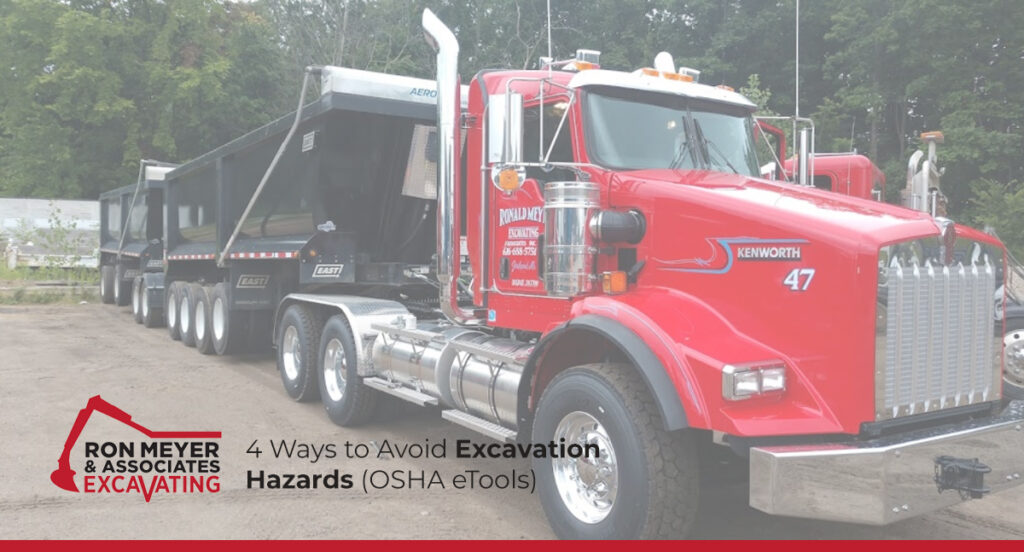
OSHA requires that workers in trenches and excavations be protected, and that safety and health programs address the variety of hazards they face. The following hazards cause the most trenching and excavation injuries:
- No Protective System
- Failure to Inspect Trench and Protective Systems
- Unsafe Spoil-Pile Placement
- Unsafe Access/Egress
Per OSHA’s Trenching and Excavation Construction eTool, here are four ways to avoid excavation hazards:
1. Use Protective Systems
All excavations are hazardous because they are inherently unstable. If you are not using protective systems while working in trenches or excavations at your site, you are in danger.
Pre-job planning is vital to accident-free trenching; safety cannot be improvised as work progresses. The following concerns must be addressed by a competent person:
- Evaluate soil conditions and select appropriate protective systems. [29 CFR 1926 Subpart P Appendix A and 29 CFR 1926 Subpart P Appendix F].
- Construct protective systems in accordance with the standard requirements. [29 CFR 1926.652]
- Preplan; contact utilities (gas, electric) to locate underground lines, plan for traffic control if necessary, determine proximity to structures that could affect choice of protective system.
- Test for low oxygen, hazardous fumes and toxic gases, especially when gasoline engine-driven equipment is running, or the dirt has been contaminated by leaking lines or storage tanks. Insure adequate ventilation or respiratory protection if necessary.
- Provide safe access into and out of the excavation.
- Provide appropriate protections if water accumulation is a problem.
- Inspect the site daily at the start of each shift, following a rainstorm, or after any other hazard-increasing event.
- Keep excavations open the minimum amount of time needed to complete operations.
2. Inspect Trench & Protective Systems
If trenches and excavations at your site are not inspected daily for evidence of possible cave-ins, hazardous atmospheres, failure of protective systems, or other unsafe conditions, you are in danger.
Inspect excavations:
- Before construction begins.
- Daily before each shift.
- As needed throughout the shift.
- Following rainstorms or other hazard-increasing events (such as a vehicle or other equipment approaching the edge of an excavation).
Inspections must be conducted by a competent person who:
- Has training in soil analysis.
- Has training in the use of protective systems.
- Is knowledgeable about the OSHA requirements.
- Has authority to immediately eliminate hazards.
3. Safe Spoil Placements
Excavated material (spoils) at your site are hazardous if they are set too close to the edge of a trench/excavation. The weight of the spoils can cause a cave-in, or spoils and equipment can roll back on top of workers, causing serious injuries or death.
Provide protection by one or more of the following:
- Set spoils and equipment at least 2 feet back from the excavation.
- Use retaining devices, such as a trench box, that will extend above the top of the trench to prevent equipment and spoils from falling back into the excavation.
- Where the site does not permit a 2-foot set back, spoils may need to be temporarily hauled to another location.
4. Provide Safe Access/Egress
To avoid fall injuries during normal entry and exit of a trench or excavation at your job site, ladders, stairways, or ramps are required. In some circumstances, when conditions in a trench or excavation become hazardous, survival may even depend on how quickly you can climb out.
To avoid hazards, provide safe access/egress by:
- Provide stairways, ladders, ramps, or other safe means of egress in all trenches that are 4 feet deep or more.
- Position means of egress within 25 lateral feet of workers.
- Structural ramps that are used solely for access or egress from excavations must be designed by a competent person.
- When two or more components form a ramp or runway, they must be connected to prevent displacement, and be of uniform thickness.
- Cleats or other means of connecting runway components must be attached in a way that would not cause tripping (e.g., to the bottom of the structure).
- Structural ramps used in place of steps must have a non-slip surface.
- Use earthen ramps as a means of egress only if a worker can walk them in an upright position, and only if they have been evaluated by a competent person.
For more information, see OSHA’s Trenching and Excavation Construction eTool.
At Ron Meyer & Associate Excavating, Inc, we’ve been providing underground and commercial construction to private and commercial businesses for 39 years. As the general contractor or subcontractor, our experienced foremen, equipment operators, pipe layers, truck drivers and well-maintained equipment fleet make us an undeniable choice for your excavating services. Let’s talk about your project!

As 45 years of experience as an underground/site contactor and a third generation contractor, Ron takes time to go through each individual project with the supervisor and is responsible for all scheduling and equipment logistics. He’s also involved in all troubleshooting for projects.